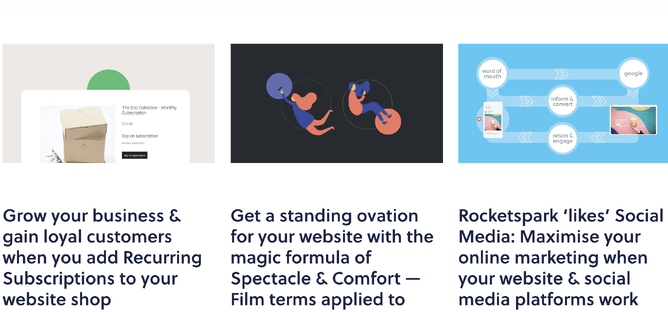One of the hottest—and in our experience, most effective—marketing strategies for your business website is writing a blog. That’s why we highlight to our customers the importance of having a blog. And yet, for many people, writing a blog is a daunting prospect. I mean, where do you start??
Here. You start here. That’s because, in this blog post, we’ll teach you how to write a blog—one that generates more traffic for your website.
1. Web writing is unique: it’s for humans and robots
Writing for the web, including blog writing, is unlike anything you were taught in high school English class. Sure, you were told to write for your audience. But your teacher never told you that your audience included robots. Yep, you heard me: robots.
Not the walking, talking, humanoid robots you see in the movies (sorry, but R2-D2 probably won’t be reading your blog anytime soon). I’m talking about web robots—usually just called bots—and more specifically web crawlers, which are computer programs that “crawl” the internet, gathering data and creating a snapshot of the web. If your blog or website can be found in Google, that means that a web crawler has “read” it. And these web crawlers are an important “audience”; how well you write for them will contribute to how highly your blog posts rank in search engines.
So if you want to bring in more visitors to your website, keep in mind this important maxim: you’re writing for humans and for robots.
Writing for humans
2. Focus on the quality
That being said, your blog should never ever ever feel like it was written for web crawlers. It needs to read well, maintain interest and be helpful—in other words, it needs to be written for humans.
That might sound obvious but, believe it or not, this wasn’t always the case. For a few dark years, a lot of the net’s content-producers paid scant regard for good writing. Why? Because they only cared about boosting Google rankings (this is essentially what all this robot business is all about—see “Writing for Robots” below for a fuller explanation). For instance, some websites overloaded their content with an unnaturally high number of keywords (a tactic called keyword stuffing), creating content that was practically unreadable for humans. That didn’t care because they were only interested in writing for bots, and since web crawlers are on the hunt for keywords, they were easily duped by these kind of tactics.
Then the robots got smarter. In more recent years, Google and other search engines have been developing increasingly sophisticated software that weeds out and penalises those sorts of methods. Instead, Google is trying to encourage websites to create high quality content—write well, and you’ll be rewarded in search rankings. So, while writing for the robots is important (which requires doing keyword research to beef up your search rankings—see below), your primary focus should still be on writing interesting, insightful, compelling content for real, flesh-and-blood people.
3. Write what you know
Content marketing, which is the fancy-schmancy name for the marketing umbrella that business blogging comes under, is based on the idea that you create something worthwhile for a potential customer. Your blog is a way to share a bit of your expertise for free, which shows people that: a) you actually have expertise, and b) you’re a nice enough company to share it. So blog on topics that you are actually know about.
One of the great things about blogging is that you can get away with being really specific. Your topics don’t have to be about the Unifying Theory of Everything. It’s totally acceptable, often preferable, to write a blog post about something “small” and highly specialised if that’s something your potential customers could find usefulor interesting. Previous Rocketspark blog posts include such niche hits as “‘Download file’: When to avoid it and when to embrace it” and “How to best display a Google map on your website.” Sure, they’re super-specialised, but they’re topics that we know are relevant to some of our customers (for the record, we’ve also tackled comprehensive, broad-appeal topics too like “Social media for business” and “SEO Basics”).
Ask yourself: What am I an expert in? What kinds of things are my clientele wanting to know about? Brainstorm a dozen potential topics and start googling them. Chances are, someone else will have blogged about it before. That’s okay! How can you make your post better than theirs? Go through this process and you’re well on your way to coming up with a few blogable topics.
4. Let the content dictate the length
In a fast-paced world of tweets, Attention Deficit Disorder and an overwhelming 1 billion websites, you’d assume that people want short, snappy, easy-to-digest blogs. Brace yourself for a shock…
Longer is often better. Digital marketing master Neil Patel found, counterintuitively, that most top-ten pages in search results for any given query have at least 2,000 words. He also found that long posts (1,500+ words) get linked to more and garner more “likes” on social media. Similarly, blogging platform Medium engaged in some sophisticated number crunching and discovered that the optimal length of a blog post was 7 minutes, which works out to roughly 1,600 words. Who’d have thunk it?
But short works too. Perez Hilton often writes very short blog posts—and as the world’s third highest-earning blogger, it’s obviously working for him. Okay, okay—of course the gossip-monger’s subject matter is hardly weighty, but that only serves to underscore the key rule-of-thumb about blog length…
The content should dictate the length. Some topics can be done n’ dusted in just 200 words. Others need 2,000 words to do them justice. Don’t just ramble on and on for the sake of bulking out your post to some illusory magic word count. Good writing is disciplined writing. Start by writing the length you think the topic deserves, then edit it down by, say, 15%. That way you’ll have a fat-free blog post that’s the right length for the topic.
5. Make it easy to scan
Even if you decide to write a novella for your next blog post, remember: whatever the length, it needs to be formatted in a web-friendly way. Web usability expert, Jakob Nielsen, famously argued that internet readers don’t really read, they scan. He made that pronouncement last century—1997, to be precise. Obviously things have a changed a fair bit since then. But readers still have a tendency to scan—in fact, Nielsen’s more recent eye-tracking studies show that readers’ eyes tend to move in an “F” pattern: a couple of horizontal scans near the top of the page, and then a vertical scan down the left-side of the page.
What does that mean for blogging? Don’t waste too much time in your intro. Try to jump right into the topic as quickly as possible so that readers know what it’s about at a glance. The fact that readers often scan—in an “F” shape or otherwise—means that your blog should be broken up into easy-to-swallow chunks, each with a scan-friendly, information-carrying sub-heading. And paragraphs should usually be shorter than they would be in offline text.
While we’re on the topic of formatting, don’t forget to use images. Yes, it’s extra work and, if you’re buying stock images, extra expense. But it’s worth it. Fact is, we humans love pictures; they pique our interest and keep us reading (or at least scanning).
6. Put a lot of thought into the headline
Your headline might just be the most important part of your blog. It’s the first part of your blog that readers will see and is the thing that will most often draw them into reading—or drive them away. 80% of people read the headline, while just 20% read the rest. But do it right and you’ll be able to boost that number.
You gotta remember that you’re not trying to come up with a title for the Great American Novel (The Grapes of Wrath) or the next Bond movie (You Only Live Twice). In other words, nothing vague, esoteric or cute. Your title should state exactly what the blog is about. And there’s a bit of a science to doing that. Let’s take a look at the headline for this blog post, which has been specially formulated to demonstrate how to write a blog heading:
Blogging for business: 8 principles for writing a blog that gets more web traffic
Here’s what makes this a strong headline:
It says exactly what the blog is about. If I try to write something flowery or poetic nobody’s going to read it. It’s an ugly truth for all the wordsmiths out there, I know, but that’s just how it is with blogging.
It puts the keywords at the beginning of the heading. Remember the “F” pattern? It means that people spend more time looking at the left-hand side of the page, so put the words that carry the most information at the start. The colon (:) is a mighty useful piece of punctuation here because it allows you to cram the start with keywords and then write something a bit clearer afterwards.
It’s results-focused. It’s not merely “How to write a blog” but “How to write a blog that gets more web traffic.” People want to know what’s in it for them.
It’s got a number in it. This is so commonplace and so particular to web writing that it’s fast becoming a parody-worthy cliché. But Content Marketing Institute has found that blog titles that have numbers in them perform 45% better than non-number titles. Use the numeral (“8”), not the word (“eight”).
It’s short. Well, short-ish. KISSmetrics has found that the ideal length of a headline is six words long. Don’t worry too much about hitting that magic six-word mark; that’s usually hard to do and if you have to sacrifice clarity, it’s not worth it (which is why I went for something longer). The rule of thumb is simply this: be succinct.
WRITING FOR ROBOTS
7. Focus on your keywords
If the prospect of writing for robots still sounds weird, it’s really just a fancy way of saying that you need to engage in the art (or voodoo, depending on who you ask) of search engine optimisation (SEO). This means crafting your blog posts in such a way that search engines, like Google or Yahoo!, put your website high up the rankings for relevant search queries. And since search engines are the ones that use web crawlers, this is where writing for the robots comes in.
Example: imagine you’re a mechanic and you decide to write a blog post for your garage’s website about how to properly dispose of used motor oil in the Dunedin (NZ) region. Anytime somebody searches “used motor oil dunedin” or “oil change dunedin”, with a bit of SEO know-how and a smidgen of luck, your blog post will appear near the top of the search results, and is therefore more likely to be clicked and read. And once someone sees how helpful your blog post is they might just decide to pay you to do the oil change instead!
SEO is a deep rabbit hole, which is why we’ve blogged about it extensively, but the most important part is this: identify your keywords. In other words, the people for whom this blog post is written—what sorts of terms and phrases are they most likely to type into Google?
Part of this is just common sense. Let’s say you own a cafe and you’re blogging about a fancy new cola you’re now stocking. Something like “soft drinks” would likely be a typical search query. But what other relevant phrases are people using?
This is where Google’s nifty Keyword Planner comes in handy. Signing up to Google AdWords (it’s free—huzzah!) gives you access to the Keyword Planner (Tools > Keyword Planner), which gives you data about about actual search queries. Type in “soft drinks”, click on the “Keyword ideas” tab, and you’ll find that in fact “fizzy drinks” is a more common search query in New Zealand (crazy Kiwis…).
Now that you’ve identified keywords—”soft drinks”, “fizzy drinks”, etc.—you simply need to use those words and phrases in your blog post. Don’t go overboard with fizzy drinks just by dropping in keywords soft drinks randomly fizzy drinks in places they don’t belong soft drinks...Did you see what I did there?? This is keyword stuffing, the unnatural overuse of keywords (see above), and it’ll land you a penalty from Google for trying to game the system. But so long as you avoid that dubious tactic, then you’ll be on the right track. Web crawlers operate by finding keywords. So peppering those terms throughout the post and, even better, in your headlines and sub-headings, boosts your chances of landing yourself an enviable ranking in the search results whenever those words are searched.
A word about SEO for Rocketspark websites…
If you have a Rocketspark website, there’s a few handy features that’ll help you write for the robots:
Your blog headline automatically becomes part of the URL (i.e., web address) for that page so its important to use important keywords in your blog headline as this helps improve your search rankings.
The headline also becomes the title tag for your page. What’s a title tag? It’s the line of blue text that comes up in Google’s search results. Learn more about title tags.
Your first paragraph becomes the meta-description—that’s the descriptive text that appears in Google results under the title tag.
You can also add a blog post to the home page. A useful little feature to get site visitors hooked on your blog (this one’s more for the humans than the robots).
8. Promote your blog on social media
Finished? Once you’ve put in the hard yards writing a solid blog post, it’s time to get it out there! Social media is your ally here. Check out our guide to promoting your blog with social media.
Conclusion
Business blogging is a powerful way to bring more visitors to your website. Writing does take time and effort, but if you follow these eight principles above then you’re well on your way to crafting a blog that really works for your audience—the humans and the robots.






